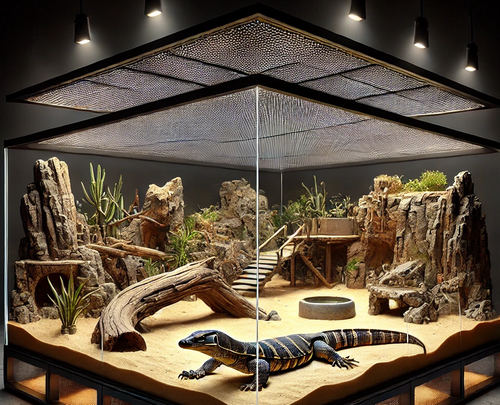The Ultimate Guide to Keeping Monitor Lizards in Australia
Posted by BioSupplies on 14th Aug 2024
Monitor lizards, known for their intelligence, striking appearance, and fascinating behaviors, are becoming increasingly popular as pets in Australia. However, owning a monitor lizard requires a significant commitment to their care and understanding of their specific needs. This guide will walk you through everything you need to know about keeping monitor lizards, including habitat setup, diet, and general care tips—all while ensuring your pet remains healthy and happy.
1. Choosing the Right Species
Australia is home to a variety of monitor lizard species, each with its own unique characteristics and care requirements. Some of the most common species kept as pets include:
- Ackie Monitor (Varanus acanthurus): Known for its manageable size (up to 70 cm) and relatively docile nature.
- Sand Monitor (Varanus gouldii): A larger species, reaching up to 1.5 meters, requiring more space and a more experienced handler.
- Mertens' Water Monitor (Varanus mertensi): A semi-aquatic species that needs a water feature in its enclosure.
When choosing a monitor lizard, consider the space you have available and your experience level with reptiles. Remember, larger species like the Sand Monitor need extensive enclosures and more complex care.
2. Enclosure and Habitat Setup
Monitor lizards need spacious enclosures that mimic their natural environment. Here’s what you’ll need:
- Size: The enclosure size will depend on the species. For example, an Ackie Monitor requires a minimum enclosure size of 120 cm (L) x 60 cm (W) x 60 cm (H), while a Sand Monitor might need an enclosure of 240 cm (L) x 120 cm (W) x 120 cm (H).
- Substrate: Use a mix of sand and soil to create a naturalistic environment. Ensure the substrate is deep enough (at least 20 cm) for digging, which is a natural behavior for many species.
- Heating and Lighting: Provide a basking spot with temperatures around 40-45°C and a cooler area around 25-30°C. Use UVB lighting to help with calcium absorption and overall health.
- Hideouts and Climbing Structures: Include rocks, logs, and other structures to allow your lizard to climb, hide, and explore.
For heating and lighting products, check out the BioSupplies range of reptile heating equipment.
3. Diet and Feeding
Monitor lizards are carnivorous, requiring a diet rich in protein. Their diet typically includes:
- Insects: Crickets, mealworms, and roaches are excellent choices for smaller species like the Ackie Monitor.
- Rodents: Larger species, such as the Sand Monitor, may require mice, rats, rabbits, quail or chickens.
- Supplementation: Dust food with calcium and vitamin supplements to ensure your lizard gets all the necessary nutrients.
You can find high-quality live food and supplements at BioSupplies.
4. Water and Humidity
While monitor lizards are generally hardy, maintaining the right humidity levels is crucial. Provide a water dish large enough for the lizard to soak in and ensure it’s always clean. Mertens' Water Monitor, for example, will need a larger water area, as they are semi-aquatic.
Maintain humidity levels according to the species’ natural habitat—Ackie Monitors prefer around 40-50% humidity, while Mertens' Water Monitors may require levels closer to 60-70%.
5. Handling and Socialization
Monitor lizards are intelligent and can become accustomed to handling with time and patience. Start slow, allowing your lizard to get used to your presence. Gradually increase handling sessions, ensuring they are calm and stress-free.
6. Common Health Issues
Monitor lizards can suffer from health issues if their care isn’t up to standard. Common issues include:
- Metabolic Bone Disease (MBD): Caused by a lack of calcium or UVB light. Ensure your lizard’s diet is supplemented correctly and that UVB lighting is available.
- Respiratory Infections: Often due to incorrect humidity or temperature levels. Regularly monitor and adjust the environment as needed.
- Parasites: Regular vet check-ups and maintaining a clean enclosure can help prevent parasitic infections.
If you notice any signs of illness, consult a reptile vet immediately.
7. Legal Considerations
In Australia, owning a monitor lizard requires a permit, which varies by state. Ensure you’re familiar with the local regulations and have the necessary permits before acquiring a monitor lizard.
8. Conclusion
Keeping a monitor lizard can be an incredibly rewarding experience for those willing to invest the time and effort. By providing the right environment, diet, and care, your monitor lizard can thrive and live a long, healthy life.
For all your monitor lizard care needs, including live food, heating, and lighting products, visit BioSupplies and ensure your pet has everything it needs to thrive.

